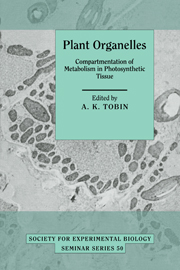Book contents
- Frontmatter
- Contents
- List of Contributors
- Preface
- Acknowledgements
- Metabolic interactions between organelles in photosynthetic tissue: a mitochondrial overview
- Metabolite transport in plant cells
- Metabolic interactions during photosynthetic and respiratory nitrogen assimilation in a green alga
- Carbon and nitrogen cycling between organdies during photorespiration
- Metabolic interactions between organelles in C4 plants
- Metabolic interactions in leaves of C3–C4 intermediate plants
- Metabolite compartmentation and transport in CAM plants
- Transport of H+, K+ and Ca2+ at the vacuolar membrane of plants
- Regulation of mitochondrial respiratory activity in photosynthetic systems
- Biosynthesis and assembly of the enzymes involved in lipid metabolism in plants
- The role of carnitine in plant cell metabolism
- Metabolic interactions of organelles in guard cells
- Transport of proteins into chloroplasts
- Metabolic interactions of organelles during leaf development
- Index
Regulation of mitochondrial respiratory activity in photosynthetic systems
Published online by Cambridge University Press: 05 December 2011
- Frontmatter
- Contents
- List of Contributors
- Preface
- Acknowledgements
- Metabolic interactions between organelles in photosynthetic tissue: a mitochondrial overview
- Metabolite transport in plant cells
- Metabolic interactions during photosynthetic and respiratory nitrogen assimilation in a green alga
- Carbon and nitrogen cycling between organdies during photorespiration
- Metabolic interactions between organelles in C4 plants
- Metabolic interactions in leaves of C3–C4 intermediate plants
- Metabolite compartmentation and transport in CAM plants
- Transport of H+, K+ and Ca2+ at the vacuolar membrane of plants
- Regulation of mitochondrial respiratory activity in photosynthetic systems
- Biosynthesis and assembly of the enzymes involved in lipid metabolism in plants
- The role of carnitine in plant cell metabolism
- Metabolic interactions of organelles in guard cells
- Transport of proteins into chloroplasts
- Metabolic interactions of organelles during leaf development
- Index
Summary
The role of mitochondria in cellular energy metabolism in both photosynthetic and non-photosynthetic tissues has been the subject of much study. In non-photosynthetic tissues most of the cell's demand for ATP is met by respiration and oxidative phosphorylation whereas in photosynthetic tissues photophosphorylation can be a major contributor to cellular ATP requirements. The pathways involved are central to metabolism and interact with many other metabolic systems. An understanding of the mechanisms that control respiration is therefore vital for a fuller comprehension of cellular metabolism and efficiency. Before attempting to answer the question of what controls respiratory activity it is important to define the system in question and its limits since there are many different levels at which control can be said to occur. Such a definition allows discrimination between internal controls of the system and the effect on the system imposed by external causes.
The scope of this chapter is restricted to the system of oxidative phosphorylation and respiration in plant mitochondria. The general properties and characteristics of plant mitochondria are well documented and the reader is therefore referred to these articles (Douce, 1985; Moore & Rich, 1985; Douce & Neuburger, 1989; Moore & Siedow, 1991) for a fuller description of their structural and functional properties. The system is defined as comprising the electron transport chain, the intramitochondrial NAD+ and phosphate pools, the adenine nucleotide translocator, the ATP synthase, the protonmotive force and the proton conductance of the inner membrane.
- Type
- Chapter
- Information
- Plant OrganellesCompartmentation of Metabolism in Photosynthetic Tissue, pp. 189 - 210Publisher: Cambridge University PressPrint publication year: 1992
- 1
- Cited by

